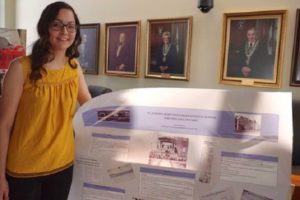Residential School history displayed at Fort William City Hall

By Rick Garrick
THUNDER BAY—The relocation of St. Joseph’s (Fort William) Indian Residential School from the Fort William community to Thunder Bay was highlighted in A Residential School Poster Display at City Hall in Thunder Bay on May 19.
“It was quite interesting that this one was moved to the City of Fort William [now part of Thunder Bay],” says Lexie Solomon, a Lakehead University Indigenous Learning student from Fort William. “It was actually done because of the Fort William [band] members; once they were relocated to where we are now, there was a conflict of where the new institution should be, whether in Squaw Bay or at the base of Mount McKay. So it was just decided to put it [in the City of Fort William] to avoid conflict.”
The Fort William community had to relocate from their original location on the north shore of the Kaministiquia River due to the federal government’s appropriation of their land in 1905 for a proposed Grand Trunk Pacific Railway terminus. Originally established in 1870 as The Orphan Asylum of Fort William, the residential school was moved to the city in 1907 and closed in 1964. It was demolished in 1966.
“Many people assume this was just an orphanage, but it was actually a residential school,” Solomon says. “That was one common thing that people were saying. They were surprised that it wasn’t an orphanage.”
Solomon’s poster display was one of about 25 that were prepared by Lakehead University Indigenous Learning students and displayed at City Hall in collaboration with Thunder Bay’s Aboriginal Liaison Office. The students selected the schools from the Aboriginal Healing Foundation – Residential School Information list and prepared a snapshot overview for their Residential School Class – Indigenous Learning 3110.
“This was a good opportunity for people to become educated on this topic,” Solomon says. “It is important to keep talking about it so the children’s stories aren’t forgotten.”
Pays Plat’s Clifford Mushquash, who grew up in Sioux Lookout, about a four-and-a-half-hour drive northwest of Thunder Bay, prepared a poster display on the Pelican Lake Indian Residential School, which is located near Sioux Lookout.
“There’s been a lot of stories of abuse coming out of the school from a number of the students and that formed a certain aspect of my project,” Mushquash says. “By the 1950s, after 30 years of being open, it had fallen into some serious disrepair with a lot of leaking roofs, flooding in the basement and inadequate fire escapes. There is documentation of that from school officials to the federal ministry with little action.”
Mushquash says it is important for all Canadians to know their country’s history.
“This is a very big part of our history and it has directly affected generations of individuals, of families,” Mushquash says. “It has torn families apart, it’s not something that should soon be forgotten. When we know our history and we can recognize our history, we’re apt not to repeat that history. I think it is important that we carry this [knowledge] with us.”
Mushquash also did an update on what is currently happening at the former residential school site, where Northern Nishnawbe Education Council’s Pelican Falls First Nations High School now operates in a recently built school.
“They have a Christian Elder and a traditional Elder in the school that work alongside the staff to provide service to the students,” Mushquash says. “Language is embraced in the school, culture is embraced in the school. They have a traditional course that teaches things like medicine harvesting, trapping, snaring, birchbark work in complement to their regular curriculum.”


